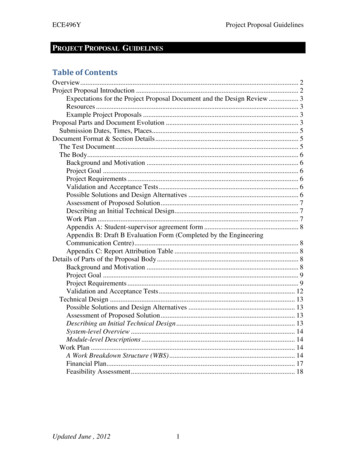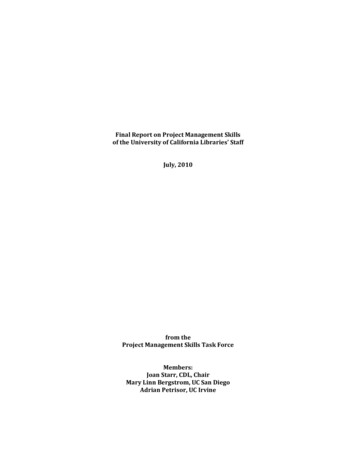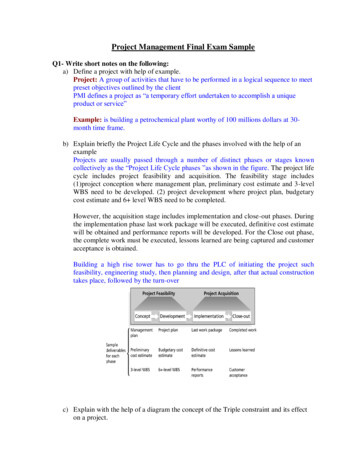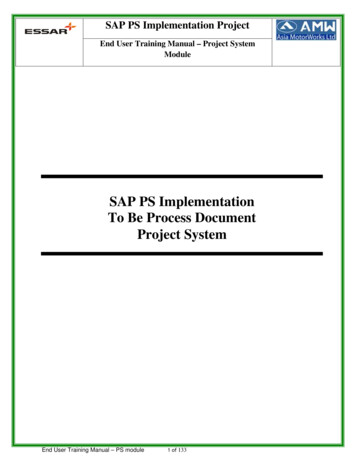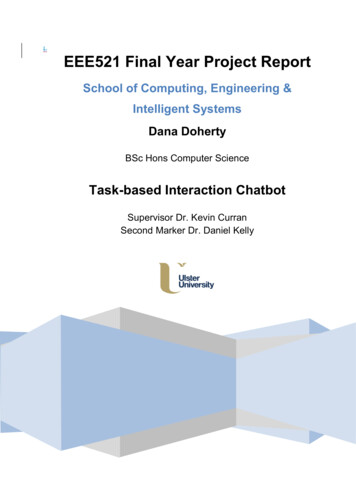
Transcription
LEEE521 Final Year Project ReportSchool of Computing, Engineering &Intelligent SystemsDana DohertyBSc Hons Computer ScienceTask-based Interaction ChatbotSupervisor Dr. Kevin CurranSecond Marker Dr. Daniel Kelly
Plagiarism StatementI declare that this is all my own work and does not contain unreferenced material copied from anyother source. I have read the University’s policy on plagiarism and understand the definition ofplagiarism. If it is shown that material has been plagiarised, or I have otherwise attempted to obtain anunfair advantage for myself or others, I understand that I may face sanctions in accordance with thepolicies and procedures of the University. A mark of zero may be awarded and the reason for thatmark will be recorded on my file.I confirm that the Originality Score provided by TurnItIn for this report is .[your signature]AcknowledgementsI would like to take this opportunity to thank my project supervisor Dr Kevin Curran for hiscontinuous guidance and encouragement throughout the entirety of the project. I would also like tothank Dr Daniel Kelly for his feedback and guidance during the development stage. Finally I would tothanks Dr Michael McTear for his guidance and valuable and critical input on the Testing andEvaluation Chapters.
Contents1. INTRODUCTION . 11.1 AIMS & OBJECTIVE . 11.2 LITERATURE REVIEW . 21.3 CHATBOTS IN INDUSTRY . 31.3.3 CHATBOTS . 61.4 NATURAL LANGUAGE UNDERSTANDING ENGINE . 71.5 ARTIFICIAL INTELLIGENCE . 81.5.1 ARTIFICIAL INTELLIGENCE METHODS . 81.6 CHATBOT ARCHITECTURE . 101.7 SUMMARY OF REPORT . 101.8 CONCLUSION . 112. REQUIREMENTS SPECIFICATION AND ANALYSIS . 112.1 PROBLEM STATEMENT . 112.2 PROPOSED SOLUTION . 122.3 SOFTWARE DEVELOPMENT METHODOLOGIES . 122.3.1 WATERFALL METHODOLOGY . 132.3.2 INCREMENTAL MODEL. 132.3.3 CHOSEN METHODOLOGY . 142.4 INFORMATION GATHERING TECHNIQUES . 142.4.1 CHOSEN INFORMATION GATHERING TECHNIQUE . 162.5 FUNCTIONAL AND NON-FUNCTIONAL REQUIREMENTS . 172.5.1 FUNCTIONAL REQUIREMENTS . 182.5.2 NON-FUNCTIONAL REQUIREMENTS . 182.6 SOFTWARE AND HARDWARE SPECIFICATION . 192.6.1 SOFTWARE REQUIREMENTS . 192.6.2 HARDWARE REQUIREMENTS. 192.7 PROJECT PLANNING . 19
2.7.1 PROJECT MILESTONES AND DELIVERABLES . 202.7.2 DEVELOPMENT ITERATION BREAKDOWN . 212.7.3 RISK MANAGEMENT. 222.7.4 PROJECT MANAGEMENT . 233. DESIGN . 253.1 ARCHITECTURAL DESIGN. 253.2 DATABASE DESIGN. 293.3 CLASS DIAGRAM . 303.4 SPEECH RECOGNITION . 323.5 ACTIVITY DIAGRAMS . 333.6 SEQUENCE DIAGRAMS . 383.7 CONVERSATIONAL USER INTERFACE DESIGN . 403.8 DIALOG DESIGN. 424. IMPLEMENTATION AND TESTING . 464.1 CONFIGURING THE DEVELOPMENT ENVIRONMENT: . 464.2 AUTHENTICATION: . 484.3 DATABASE DEVELOPMENT . 484.4 GOOGLE TWO-FACTOR AUTHENTICATION: . 494.5 OPEN BANKING API: . 514.6 WEBHOOK DEVELOPMENT: . 564.7 CHATBOT WEB CLIENT. 634.8 GIT VERSION CONTROL. 645. TESTING . 645.1 SIMULATED CONVERSATIONAL TESTING . 655. 2 WEBHOOK TESTING . 735.3 USER TESTING:. 746. EVALUATION. 756. 1 CONCLUSION . 796.2 FUTURE ADVANCEMENTS . 79
6. REFERENCES . BBA COMPETITION REPORT 23.06 WEB 2.0.PDF . 47.APPENDICES . 87.1 APPENDIX A QUESTIONNAIRE RESULTS USER REQUIREMENTS . 9
EEE521 Final Year Project 2017/18B00659303AbstractPeople interact with systems more and more through voice assistants and chatbots. The days of solelyengaging with a service through a keyboard are over. These new modes of user interaction are aided inpart by This research will investigate how aadvancements in Artificial Intelligence andMachine Learning technology.are being used to improve many services. Inparticular it will look at the development of chatbots as a channel for informationdistribution.This project aimed to implement a web-based chatbot to assist with onlinebanking, using tools that expose artificial intelligence methods such as natural language understanding.Allowing users to interact with the chatbot using natural language input and to train the chatbot usingappropriate methods soit will be able to generate a response. The chatbot will allow users toview all their personal banking information all from within the chatbot.The produced prototype was found to be a very The TrueLayer API will be used to retrieve accountinformation which hasjust recently been made accessible to the public. This is part of the Open BankStandard which allows developer’s access banking data through the APIRest client. This came about through the bank as a platform (BaaP) standard.useful tool to justify the need of a modern method of interaction to be integrated within many servicesoffered by banks and financial businesses. In an industry with low user satisfaction rates and limitedtechnology to increase accessibility. It is clear the chatbot overcomes the challenges banks face toincrease the use of their services and gain a competitive edge over leading competitors.With many people adopting Smart Assistant Devices such as Google Home or Amazon’s Alexa. Thechatbot was tested across a range of devices such as Google Home and Assistant on android devices tooutline the key differences between the two modes of interaction , spoken and text dialog. These testwere carried out to identify the value in integrating such technology surrounding the recent interest in1
EEE521 Final Year Project 2017/18B00659303chatbots and conversational interfaces. Proving chatbots can be applied to a specific domain to enhanceaccessibility, reaffirming that they are more than just a passing fad and have a viable use.2
EEE521 Final Year Project 2017/18B006593031. Introduction“Digitalisation, the surge of mobile and internet connected devices has revolutionised the way peopleinteract with one another and communicate with businesses” (Eeuwen, M.V. ( 2017)). Millennials areaccepting and supporting new technology into the routine of their everyday life, this is becoming moreis becoming more prevalent as technology companies are streamlining ArtificialIntelliIntelligence (AI) into the products they offer, such as; Google Assistant, GoogleHome and Amazon Alexa. The new and upcoming generation are expected to becritical and game changing customers for businesses. “They demand effortless experiences, answerswithin seconds, not minutes and more intelligent self-service options” (Teller Vision,, . ( 2017)).The banking and the financial service industry was one of the first industries to adopt technology. Thisintegration has grown massively, helping banks reach a wider customer base enabling them to performtheir banking conveniently (Baptista and , G. and Oliveira, , T. (2015)).Banks are becoming ever more competitive with each other to adopt the newest advancements intechnology to provide an improved delivery service to satisfy customers. Ulster Bank, Deloitte, AIBand PTSB are wanting to focus on integrating new technology to improve the speed at whichtransactions are acknowledged (Global Banking News, . (, 2017)). With this in mind the relationshipwith the customer is always evolving due to the growth of technology.Banks are now enabling the use of technology so customers can perform more tasks online, such as;cheque image clearing to allow the payment of cheques remotely and intelligent chatbots to increasecustomer service and assist employees. A chatbot is a “simple software program that can respond tocustomer prompts i.e. what’s my bank balance?” (Entrepreneur, . (, 2016)). Mastercard has launchedKai an artificial intelligent chatbot and other bots for financial services. They can handle customerqueries such as: ‘what is APR?’, requests, look at spending habits and solve problems. This in turnenables financial institutions to provide a new, engaging experience and strengthen their relationshipwith the customer, with the aid of natural language used by bots to establish a more personal andcontextual conversation (Wire, . (, 2016)). The focus of this project is to implement these newtechnologies to create an intelligent chatbot to enable banks to appeal to millennials and potentially gaina lifelong customer.1.1 Aims & ObjectiveThis work aims to provide a fast and convenient way to manage your banking. The online bankingchatbot will help facilitate the user with queries and assist with personal banking.1
EEE521 Final Year Project 2017/18B00659303The application will allow users to c:Check their bBalance,View aAccount dDetails & sView Ttransactions. There will be integration of SMS, currency conversions, two factor authenticationand the ability to interact with the service through a chatbot. SMS confirmations and email mini statement schedule. The StarlingAPI will be used to access the users banking information requestedthrough the chatbot. Currency conversions Askqueries through chatbot and get appropriate and immediateresponses Improve customer service through conversation using the chatbotThe chatbot will be implemented using the Laravel Framework and Dialogflow.The Dialogflow will be utilised as the NLU to perform artificial intelligencemethods such as; Natural Language Processing (NLP), POS tagging, and entityrecognition to analyse text and carry out the appropriate actions. Dialogflow is aNatural Language Understanding Engine (NLU) used for the extraction of entitiesand intent from a user’s message.Google Two-Factor Authentication will be implemented as an extra measurementof security for the customer. This ensures that no one else can access their accountand view their personal banking information. A unique code will be generatedand sent to their phone from scanning a QR code displayed after a successfullogin. Users will download the Google Authenticator app onto their mobiledevice to receive the unique code generated which will grant access to the chatbot.1.2 Literature ReviewThe banking industry has multiple electronic delivery channels in use to distribute technology assetsand services for the benefit of their customers. Online banking is a commodity of commerce within2
EEE521 Final Year Project 2017/18B00659303financial services as well as banking industries (Ajimon and , G. G.S. Gireesh K,.(George and Kumar,2013)). Advancements in technology has transformed many of our services into the digital era and thebanking industry is one of the primary industries to avail of these advancements to improve theirservices. Currently within the UK two paradigms are available for online banking. One of which is anintegrated internet bank which still operates through the branch but has an online presence. The other,a stand-alone internet bank, that operates completely independently and its only existence is solelythrough the internet (MarketLine, 2017).Banks implement technology to strengthen their processing capacity, acquire a larger customer baseand expand the services they could offer (Consoli, . (, 2005)). The use of internet banking has grown indemand enormously in the last decade. “15% of branch customers use online banking once a day, 59%once a week, 77% at least once a month and 53% were confident in carrying out the best part of theirbanking online” (Barty, J. and Recketts, T. BBA, (2014)). Online banking has become more popular asit negates the need for customers to visit their local branch as they can manage their finances on the goto meet the demand of modern life. This is evident as branchless banks are now emerging from theindustry such as Atom Bank and many banks now closing some of their branches. This is evident withthe recent closure of 11 Ulster Bank Branches in NI due to the increased number of customersperforming their banking online (The Belfast Telegraph).HoweverHowever, a recent study by Ling et al., (2016), notes that most internet banking serviceproviders struggle to get many of their customers to use their service. They identify lack of customersatisfaction when using online banking services to be a major cause. “Service quality, web design andcontent, security, privacy, speed and convenience” (Ling et al., 2016) are stated identified as the topfactors influencing customer satisfaction This suggests that there is a lack of technology in place toenhance the customer online banking experience which could be improved by integrating a chatbot toprovide an efficient, convenient and personal service.1.3 Chatbots in IndustryMost businesses and organisations are understanding the potential benefits of machine learning andartificial intelligence to have a positive change on how they perform business. Artificial intelligencehas progressed to allow the development of more sophisticated chatbots. Organisations are focusing onspecific areas of user engagement that take up a lot of time but can be replaced through the use of achatbot. Chatbots can understand what the customer needs from a single text instead of the customerhaving to follow a process of multiple steps.Chatbots are used to automate customer service and reduce manual tedious tasks performed byemployees so they can spend their time more productively on higher priority tasks. Establishments thatregularly deal with its customers have discovered the potential of chatbots as a channel to distribute3
EEE521 Final Year Project 2017/18B00659303more efficient and immediate information to customers in comparison to a customer servicerepresentative regarding queries and issues (Onufreiv, YY. , 2017).HDFC Bank has merged with Niki.ai an artificial intelligence company to develop a state of the artconversational banking chatbot ((HDFC Bank,. , 20177)). The chatbot is accessible through the banksFacebook Messenger allowing users to utilise e-commerce and banking transactions all within thechatbot.There is also a chatbot integrated within the HDFC login page to assist in online banking. The chatbotwas developed as a concierge service, this is definitely one approach that can increase customersatisfaction within online banking enabling banks to develop a better relationship with its customers.Chatbots will renew and modernise the customer service industry and the main sectors outlinedincluding the banking and healthcare sector (Newswire, ., 2017). Industries such as; retail, healthcare,e-commerce and banking, are expected to achieve considerable savings from integrating a chatbot.Between 2017 and 2020 chatbots are estimated to make savings of 8 billion per annum for businesses.The majority of savings will be made through customer service as customers can now ask queries aboutbanking through the chatbot rather than having to call the bank, allowing banks to save on call centrestaff. The study predicted that the integration of chatbots within the banking industry would rise from12% to 90% by 2022.Most online banking services would benefit from having a chatbot integrated into their services. Theuse of bots help internet banking service providers establish a better relationship with its customers.Customers can get answers to query’s immediately, conduct e-commerce and banking operations allfrom within the one bot conversation. This is another benefit of using an online banking system withand integrated chatbot as “87% customers that bank online prefer to execute their personal financeoperations within a single site” (Dauda, et al., 2015).W.B. King, W.B. (2017), records a survey conducted by Personetics which identified “40% of itsclients are planning to integrate a bot into its services within the next 2 to 3 years and 70% said AI wasan exciting opportunity”. This clearly identifies the demand and need for a chatbot within the financialservices Industry.4
EEE521 Final Year Project 2017/18B00659303Figure 1: Figure 1.3.1 - Interest in chatbots within the Financial Industry (Source: W.B. King, W.B2017)Mark ZuckerBerg CEO of Facebook, believesC chatbots provide more personal and immediate waysfor customers to communicate with an organisation allowing them to provide consistent and appropriatecustomer service at scale (Conversational Business, 2017).Facebook has now released its ownMessenger Bots, which allows organisations to develop their own Chatbot through Messenger to delivertheir services.Facebook are also developing AI methods to obtain specific information related to users across relevanttopics. The acquired information is used as a dataset to develop and improve their Artificial Intelligenceso they can analyse, group and rate each user post (Rossmann et al., 2017).“44% of US consumers prefer to interact with a chatbot compared to a human in relation to customerqueries” (Wellers et al., 2017). This is evident as Chatbots are also becoming more prevalent in otherindustries such as; insurance, recruitment, media and pharmaceuticals.5
EEE521 Final Year Project 2017/18B00659303Figure 1.3.2: Industries piloting chatbots (Source: Etlinger,. , 2017)Figure 1.3.2 2. displays the tasks that can be replaced with the integration of chatbots into anorganisation, with the goal of advancing access and use over time.1.3.3 ChatbotsA chatbot is a software tool that utilises natural language processing (NLP) for human machineinteraction (HMI) and Machine Learning (ML). “The complexity of a chatbot is directionallyproportional to the scope of the domain”. An open domain requires a larger knowledge base, whereas,a closed domain has a more specific knowledge base that was developed to achieve a specific goal(Gregori, E. , 2017).6
EEE521 Final Year Project 2017/18B00659303Chatbot technology initially began in the 1960s to determine whether a chatbot could be portrayed as ahuman. Throughout the 1980s there was an elevated amount research carried out on natural languageinterfaces which lead to the development of sophisticated chatbot architectures such as A.L.I.C.E. Thischatbot architecture is one of the earlier chatbots developed in 1995 by Dr Wallace which is now opensource, the acronym stands for Artificial Linguistic Internet Computer Entity. This is a chatbot you cancreate through interaction as it will learn from previous interactions to create its knowledge base. Itsknowledge is saved in AIML (Artificial Intelligent Mark-up Language) files which evolved from theExtensible Mark-up Language (XML) (Shawar, B.A and and Atwell, E, 2007).Chatbots are developed using two approaches; a rule based approach where chatbots operate by movingthrough branches of a tree diagram of an expert system. The second approach involves advancedartificial intelligence and machine learning, thus the chatbot can learn from the conversations,generating appropriate responses to continuously improve over time (Watson, A. 2017).There are two modes in which chatbots can simulate a conversation with users which include :Ssystem-initiated chatbots where– they commence the conversation with the user andUser-initiated chatbots where- the user directs the conversation instead.Systems that incorporate the two methods of initiation are known as mixed initiative systems (Duijst,D. 2017).1.4 Natural Language Understanding EngineThe chatbot engine is thought of as one of the most critical elements of a chatbot, alias “NaturalLanguage Understanding (NLU) engine” ( Kar, R and Haldar, R. 2016). The NLU holds liability forthe translation of conversational dialogs to actions which are understood by the machine. NLU enginesuse a variety of artificial intelligence methods to understand the natural language used in conversationalinterfaces such as chatbots. These methods consist of: Natural Language Processing (NLP) and MachineLearning (ML) (Kar, R and Haldar, R. 2016).Googles Dialogflow, previously known API.ai, is a natural language understanding engine thatidentifies the intent and context from the natural language in user supplied utterances. These conceptsare used to develop the behaviour of the chatbot and how coherently it interacts with the user. Intentsare used to establish a connection between the user input and the appropriate action to be executed bythe chatbot in order for the user to achieve their goal. Contexts are utilised to differentiate andunderstand user input which may have an alternative meaning depending upon the currentconversational context (Gregori, E. 2017).7
EEE521 Final Year Project 2017/18B006593031.5 Artificial Intelligence“Artificial Intelligence is neither a new technology nor a machine”. Artificial intelligence is therecognition of outcome-direction which is the rapid analysis of live data to achieve the expected goal.Outcome-directed thinking splits from the confines of the rule-directed approach that is accomplishedthrough artificial intelligence.The generalised practice of AI can be broken down into a straightforward process which does notrequire an experienced level of proficiency to understand. First of all, a numerical representation isestablished for the target or outcome. Specific data is then associated with the target is gathered andconditions and behaviours are investigated to increase the likelihood of achieving the expected target.Multiple aspects can determine the outcome. The weight of each aspects effect is computed. “AI usesthe relative weighting of each aspect to create a prediction (evaluation) formula” (Yano, K. 2017).Lastly, the formula devised from the weighted aspects are employed to business decisions (Yano, K.2017). AI can be classified into four groups: “systems that think like humans, systems that act likehumans, systems that think rationally and systems that act rationally” ((Russell, S.J and Norvig, P.1995).AI is generally categorised as strong and weak AI: strong AI is the production of human-like intelligentsystems. Weak AI would be the integration of intelligent algorithms embedded within a system.“Machine learning, deep-learning, naturallanguage processing and neural networks are often summarised under the term of AI” (Exner-Stöhr, etal., 2017)1.5.1 Artificial Intelligence Methods“Natural Language Processing (NLP) is a theory motivated range of computational techniques, for theautomatic analysis and representation of human language” (Jurafsky , D and Martin, J.H. 2017). NaturalLanguage Processing technology has made great advancements in machine learning based systems tobe able to extract meaning from natural language utterances also known as sentiment analysis (Cambriaand White, 2014).There are many techniques used in NLP for the analysis of natural language include Entity recognition:which Entity Recognition is a technique which rrecognises entities in text. The most common entitiesinclude; nouns, organisations, people and places.Named Entity Recognition (NER) is the task of finding every instance of a named entity in text andlabel its type in order to classify it correctly (Jurafsky , D and Martin, J.H. 2017).8
EEE521 Final Year Project 2017/18B00659303“Entities are domain specific information extracted from the utterance that maps the natural languagephrases to their canonical phrases in order to understand the intent. They help in identifying theparameters which are required to take specific action” (Kar, R and Haldar, R. Kar and Haldar, 2016).Establishing the context of the of the users message is a vital feature that allows the chatbot to deal withsituations that it may not be able to carry out a specific action for. This is due to the user input beingvery vague or may have an alternative meaning. The context is the capacity of a chatbot to sustain itsstate, also referred to as the number of user supplied input (utterances) when the context is extractedand the appropriate intent is paired to conduct the desired action for the user.Intents are the core backbone of conversational interfaces. The intents represent what the customer iswanting to achieve such as ‘show me my balance’. The text sent by the user in natural language isanalysed to identify the corresponding intent of the text. This requires matching a specific user suppliedphrase with an appropriate action to be executed by the system. The chat bot would then returnappropriate dialog in order for the user to achieve their goals.Actions are the processes or steps executed by the system when the intent of a message is identified,they contain parameters which categorise and define its properties (Kar, R and Haldar, R. Kar andHaldar, 2016).Sentiment analysis incorporates multiple natural language processing techniques in order to extractmeaning and polarity from text. Polarity detection classifies text to be either positive or negative andmeasures the intensity of the overall polarity detected. Sentiment analysis achieves a more in depthunderstanding of the contextual role of each concept within a given piece of text (Cambria, E. andWhite, B, 2017).Part of Speech (POS) Tagging: this involves assigning a label to each word in the userinput with its part of speech (e.g. noun, verb, adjective, etc.). The labels or tags can berule-based (a manually developed set of rules is defined to establish part of speechfor ambiguous words provided in the conversational context). The labels can also bedeveloped utilising advance
banking, using tools that expose artificial intelligence methods such as natural language understanding. Allowing users to interact with the chatbot using natural language input and to train the chatbot using appropriate methods so it will be able to generate a response. The chatbot will allow users to






